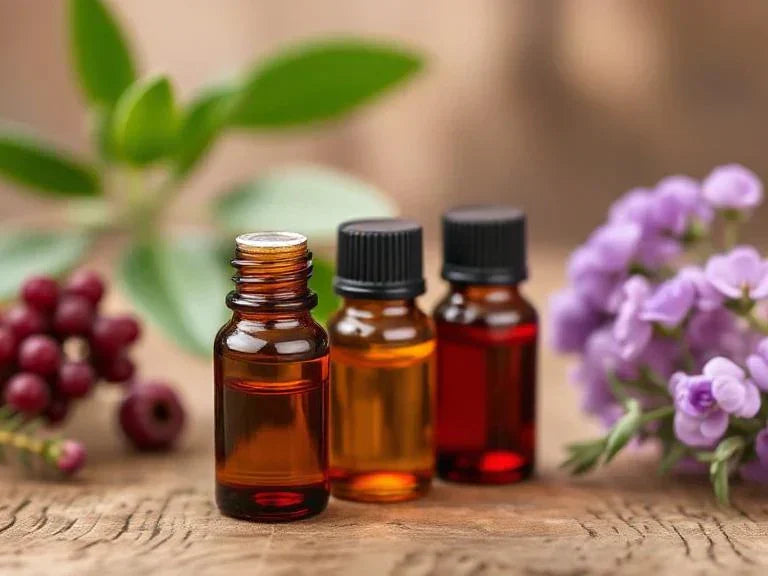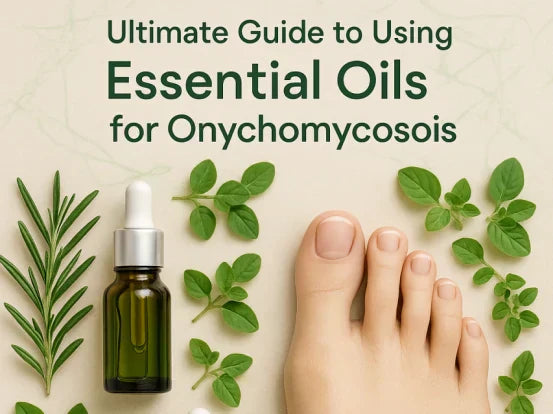Healthy circulation matters for everyone. Blood flow delivers oxygen and nutrients to every cell, supports energy, and even helps the skin and muscles repair. Yet, at least 1 in 3 adults experience issues like cold hands or feet, achy legs, or varicose veins—classic signs of poor circulation. If you spend long hours sitting or have a condition like diabetes or high blood pressure, you may face circulation problems more often. Proper movement, hydration, and nutrition always come first, but more people are exploring essential oils for circulation as part of their wellness toolkit.
Can the right oils support healthy circulation? Are some better for easing heavy limbs, swelling, or discomfort than others? Explore the best essential oils for circulation and learn how to use them safely and effectively, based on current research.
You can also explore our collection of aroma diffusers to enhance your essential oil experience at home.
Quick Reference Table: Top Essential Oils for Circulation
| Essential Oil | Key Component | Primary Mechanism | Typical Use Cases | Safety Notes |
| Rosemary | Camphor, Cineole | Improves local blood circulation | Varicose veins, leg massage | Dilute; avoid during pregnancy |
| Lavender | Linalool, Linalyl acetate | Enhances coronary flow | Heart health, stress reduction | Dilute; patch test for skin issues |
| Cypress | alpha-Pinene, Limonene | Boosts blood & lymph flow | Massage for veins, swelling | Dilute; avoid if allergic to evergreens |
| Peppermint | Menthol | Vasodilation, increases blood flow | Leg massage, pain, fatigue | Use small amounts; avoid near eyes |
| Ginger | Gingerol, Zingiberene | Anti-inflammatory, boosts flow | Massage for cold limbs, stiffness | Hot oil; dilute and patch test |
| Lemon | Limonene | Vasoprotective, circulation support | Blend ingredient, light massage | Phototoxic; avoid sun after using |
| Black Pepper | Piperine, Caryophyllene | Warming, stimulates local flow | For cold hands/feet, with carrier oil | Warm sensation; dilute well |
How Circulation Works and the Science Behind Essential Oils
What Is Circulation?
Circulation is the movement of blood through the body via the heart, arteries, veins, and capillaries. Good blood flow supplies cells with nutrients and oxygen, helping the body regulate temperature, repair tissues, and remove toxins.
Poor blood flow in the legs can cause varicose veins, numbness, or swelling. If left unaddressed, it can lead to bigger problems such as clots or skin ulcers.
How Can Essential Oils Help Blood Flow?
Essential oils for blood circulation contain natural chemicals that can:
Dilate blood vessels (widen them for better flow), such as menthol in peppermint.
Reduce inflammation, helping blood move more freely (ginger, rosemary).
Stimulate capillary function and lymph flow (cypress, black pepper).
Boost relaxation, which can lower blood pressure and ease tension (lavender).
Evidence and Limitations
Most research shows that essential oils can improve local circulation when applied with massage. For example:
Rosemary oil increased local blood flow in laboratory experiments.
In a small clinical trial, lavender essential oil increased coronary (heart) blood flow.
Most data for oils like cypress and lemon come from traditional use and expert recommendations, with less support from large trials.
Note: Essential oils should not replace medical treatment for blocked veins or serious blood disorders. Always consult a healthcare provider if you have a diagnosed condition.
Essential Oils for Circulation: Detailed Profiles
Let’s look at how the most commonly used essential oils help circulation and blood flow.
Rosemary Essential Oil
Mechanism: Boosts local blood circulation, warms tissues, and soothes leg discomfort.
How to Use: Mix 3–5 drops with 1 tablespoon of coconut oil or sweet almond oil. Gently massage into legs or areas with poor blood flow.
For: Varicose veins, tired or heavy legs, muscle recovery.
Safety: Avoid using rosemary oil during pregnancy, and always perform a patch test.

Peppermint Essential Oil
Mechanism: Menthol content helps dilate blood vessels, allowing more blood to flow through. Creates a cooling, tingling effect.
How to Use: Dilute 2 drops in 1 tablespoon carrier oil. Massage onto calves or feet.
For: Muscle aches, cold extremities, boosting circulation in legs after sitting.
Safety: Avoid sensitive skin areas, eyes, and use in moderation. Do not use infants.

Cypress Essential Oil
Mechanism: Stimulates the movement of blood and lymph, possibly easing swelling and improving vein tone.
How to Use: Combine 3–4 drops with carrier oil for direct leg or foot massage. Excellent as part of synergistic blends.
For: Poor circulation in the legs, swelling, discomfort.
Safety: Avoid undiluted use; do not use if allergic to pine or cypress trees.

Ginger Essential Oil
Mechanism: Naturally warming; supports blood flow by reducing inflammation and mildly dilating vessels.
How to Use: 2–3 drops in a tablespoon of carrier oil; massage on cold feet or hands.
For: Cold limbs, chronic stiffness, “pins and needles” sensations.
Safety: May cause warmth or redness; always dilute.

Lavender Essential Oil
Mechanism: May enhance coronary flow and relax both mind and body, indirectly improving circulation.
How to Use: Diffuse in a room, or blend with carrier oil for chest or hand massage.
For: Stress-related high blood pressure, improved heart relaxation, muscle ease.
Safety: Skin-safe when diluted; avoid some sedative medications.

Lemon Essential Oil
Mechanism: May support healthy vein walls and circulation, especially when combined with other oils.
How to Use: Up to 2 drops per tablespoon of carrier oil, in blends for leg massage.
For: Supporting vein tone, reducing feeling of heaviness in legs.
Safety: Photo-sensitive; avoid direct sun exposure after use.

Black Pepper Essential Oil
Mechanism: Stimulates warmth in the applied area, which can help draw in blood and enhance flow.
How to Use: Always blend with a carrier oil and apply to cold or stiff areas.
For: Cold hands and feet, stiff joints, massage for energy.
Safety: Can feel warm or hot; always dilute well.

Which Essential Oils Are Best for Leg Circulation?
Cypress, rosemary, and peppermint are often recommended as the best essential oils for circulation in legs, especially for those with varicose veins, swelling, or feelings of heaviness.
Choosing & Using Essential Oils by Specific Needs
Not all circulation issues are the same. Here are ways to customize your approach:
For Diabetes-Related Circulation Problems
Best oils: Ginger, black pepper, cypress (stimulate weak blood flow safely)
Application: Foot and lower leg massage; focus on areas that often feel cold or numb.
After Long Sitting or Sedentary Lifestyle
Best oils: Peppermint, rosemary, cypress
Application: Massage into calves and ankles before and after periods of inactivity or travel.
For Varicose Veins and Vein Discomfort
Best oils: Cypress, lemon, rosemary
Application: Gentle upward massage toward the heart; avoid pressing directly on varicose veins.
For General Swelling and Lymph Support
Best oils: Cypress, geranium, lemon
Application: Full-leg or arm massage with light pressure, always moving toward the heart.
Tips for Blending Oils
Combining oils can create a more powerful effect. For example:
Blend Example: 2 drops cypress + 2 drops peppermint + 1 drop lemon in 1 tablespoon carrier oil.
Carrier oils like coconut, almond, or jojoba help dilute and spread essential oils, reducing any risk of irritation.
Interactive Features
Circulation Self-Assessment Quiz
How do you know if your circulation needs a boost? Rate these statements as “Often,” “Sometimes,” or “Rarely”:
My feet or hands often feel cold.
My legs feel heavy or tingly after standing or sitting.
Swelling appears in my ankles or calves.
I notice veins bulging or changing color in my legs.
Cuts on my legs or feet seem slow to heal.
If you answered “Often” to two or more, supporting your circulation could help you feel more comfortable.
Build Your Own Circulation Blend Tool
Pick your top need: (Swelling, Varicose Veins, Cold Limbs, General Fatigue)
Select up to two preferred scents: (Energizing—Peppermint, Warming—Ginger, Woody—Cypress, Comforting—Lavender, Fresh—Lemon)
Mix: Add 4–6 total drops to 1 tablespoon carrier oil.
Safety and Contraindications
Essential oils are powerful—always use them with care. Here’s how to avoid common problems:
General Safety Rules
Dilution is key: Always mix essential oils with a carrier oil (like coconut oil) before skin use. Common ratio: 3–5 drops per tablespoon carrier.
Patch test: Apply a small diluted amount to your inner arm. Wait 24 hours for signs of redness, itching, or swelling.
Avoid sensitive areas: Never put oils in eyes, mouth, or on open wounds.
Kids and elderly: Use lower concentrations or consult a doctor before use.
Safety Table: Precautions by Oil
| Oil | Avoid in Pregnancy | Drug Interactions | Skin Risk | Notes |
| Rosemary | Yes | Yes (BP meds, epilepsy) | Moderate | Hot oil |
| Peppermint | Yes (esp. first trimester) | Yes (heart meds) | Moderate | Avoid near infants, face |
| Cypress | Caution | No major | Mild | Allergies to evergreens |
| Ginger | Maybe | Blood thinners | Moderate | Warm sensation |
| Lemon | No | No major | Phototoxic | Sun sensitivity |
| Black Pepper | No | No major | Warming/burning | Dilute well |
| Lavender | No | Sedatives | Mild | Calming, gentle |
Troubleshooting
Redness or Rash: Wash area with soap and lots of water. Stop use.
Headache or dizziness from aroma: Air out the room; avoid direct inhalation of powerful oils.
Taking Medications: Check with your pharmacist or doctor.
Integrating Essential Oils with Lifestyle Changes
Essential oils alone will not solve circulation problems. Combine them with healthy routines for better results:
Move often: Take short walks, stretch your legs, and avoid sitting for long periods.
Stay hydrated: Drink water throughout the day; dehydration can slow blood flow.
Eat a balanced diet: Foods high in vitamin C and antioxidants (like berries and leafy greens) are helpful.
Massage: Regular leg or foot massage (using your favorite oil blend) can help prevent stiffness.
Compression socks: Use if recommended to help veins move blood upward.
Medical conditions: Use essential oils for circulation as supportive—never as a substitute for doctor care.
Frequently Asked Questions
Which essential oil is best for blood circulation?
Rosemary essential oil is widely considered one of the best oils for improving blood circulation. It stimulates blood flow, reduces inflammation, and helps deliver oxygen more efficiently throughout the body. This oil can be diluted with a carrier oil and massaged into the skin, especially over the legs and arms. It also has a warming effect, which promotes better circulation in colder limbs. Regular use may help relieve symptoms like numbness or tingling. However, always conduct a patch test first, especially if you have sensitive skin.
What oil is good for blocked veins in legs?
Helichrysum essential oil is often recommended for blocked or varicose veins due to its anti-inflammatory and blood-thinning properties. It may help improve blood flow and reduce swelling when applied topically with a carrier oil. Cypress oil is another excellent option as it strengthens vein walls and improves circulation. These oils should be gently massaged upward along the legs to support venous return. Consistent use over time may enhance leg comfort and reduce the appearance of varicosities. Always consult with a healthcare provider if you suspect a serious vein condition.
Which oil is used for blood circulation?
Several essential oils are used to promote healthy blood circulation, including rosemary, ginger, cypress, and black pepper oil. These oils have warming, anti-inflammatory, or vasodilating effects that encourage better blood flow. For example, black pepper oil stimulates the circulatory system, which may help alleviate muscle cramps and fatigue. Ginger oil is known to improve overall cardiovascular health and reduce blood viscosity. These oils are typically diluted and applied topically or used in aromatherapy. Regular massage with these oils can provide both therapeutic and relaxation benefits.
Does lavender oil increase blood flow?
Lavender oil is not primarily known for stimulating blood circulation, but it can have an indirect positive effect. Its calming properties help reduce stress and lower blood pressure, which can improve overall cardiovascular function. It also promotes relaxation of blood vessels, allowing for smoother and more efficient blood flow. When combined with other circulation-boosting oils like rosemary or cypress, it may enhance the overall effect. Lavender oil is especially useful in cases where poor circulation is related to anxiety or tension. Plus, it’s gentle on the skin and widely tolerated.
Which oil is best for blood circulation in legs?
Cypress essential oil is often considered the best oil for improving blood circulation in the legs. It helps strengthen capillaries and supports the vascular system, making it ideal for varicose veins and swelling. When massaged into the legs, it promotes upward blood flow and reduces fluid retention. Ginger and rosemary oils are also effective for warming cold legs and easing muscle stiffness. These oils can be blended with a carrier oil like jojoba or almond for daily use. Consistent massage, paired with mild exercise, can significantly improve lower limb circulation.
References
https://www.hopkinsmedicine.org/health/wellness-and-prevention/aromatherapy-do-essential-oils-really-work



Leave a comment
This site is protected by hCaptcha and the hCaptcha Privacy Policy and Terms of Service apply.